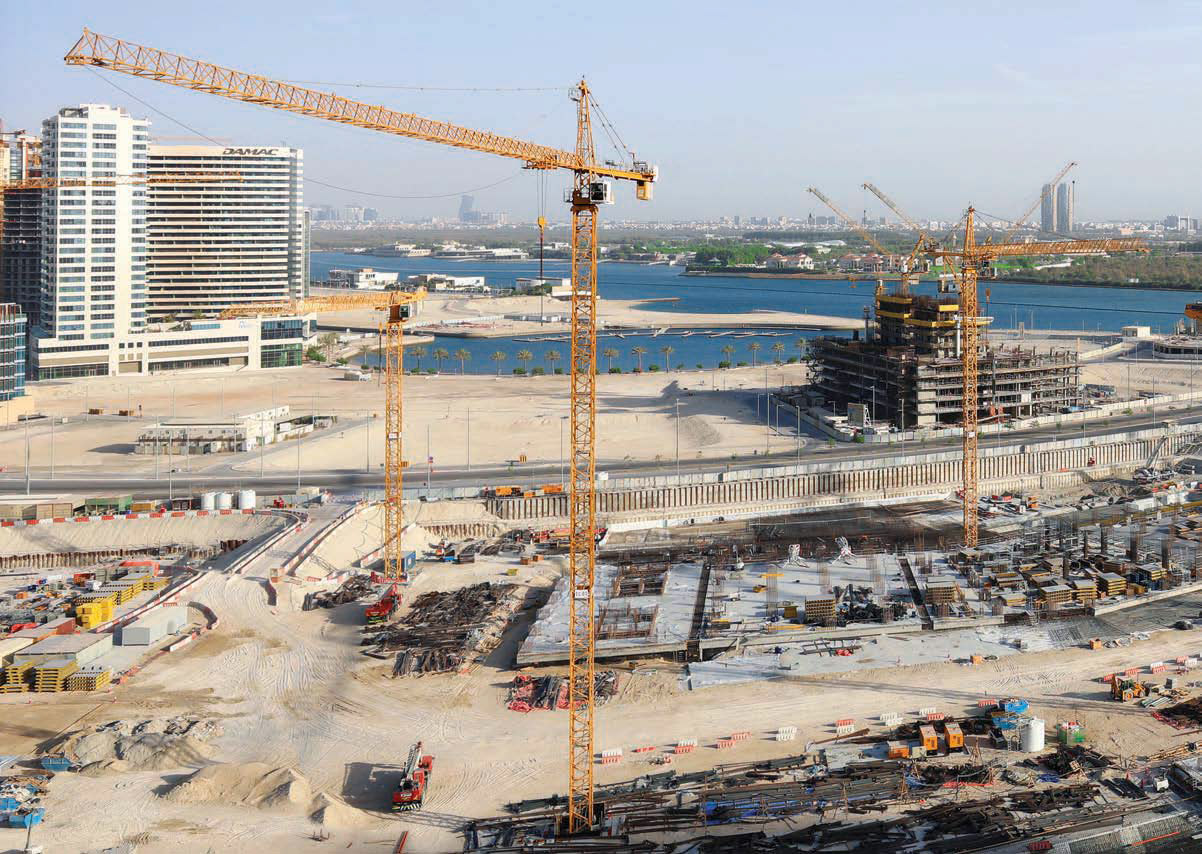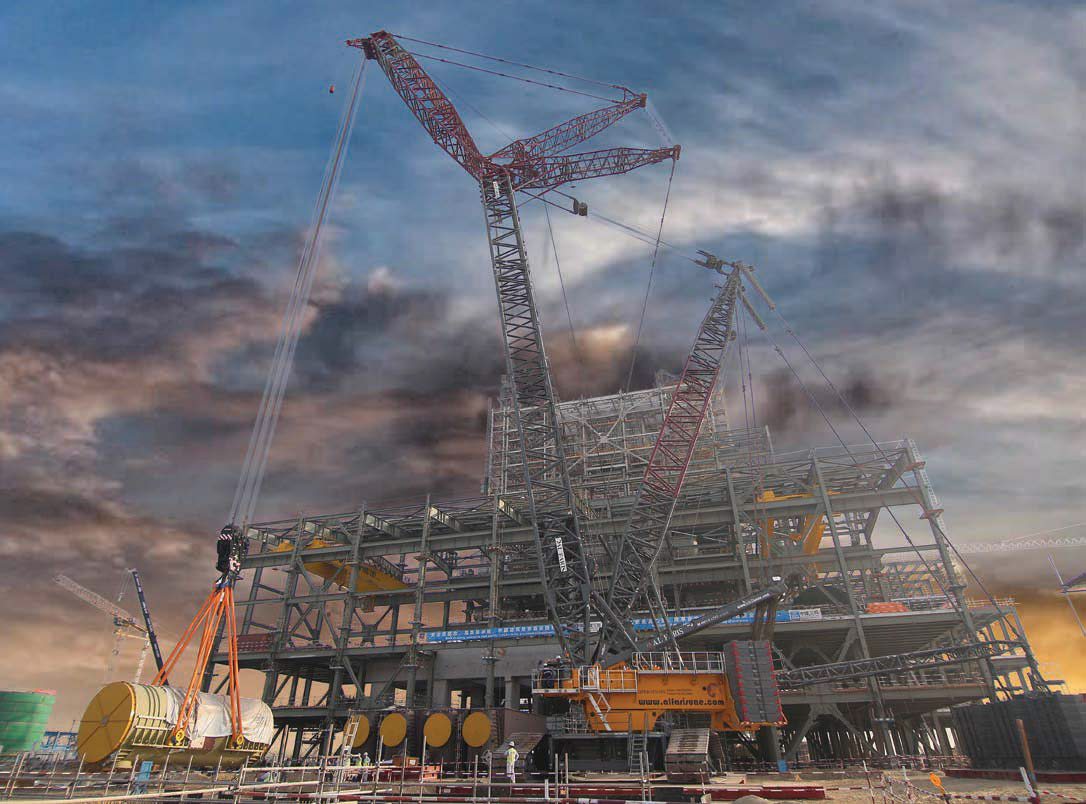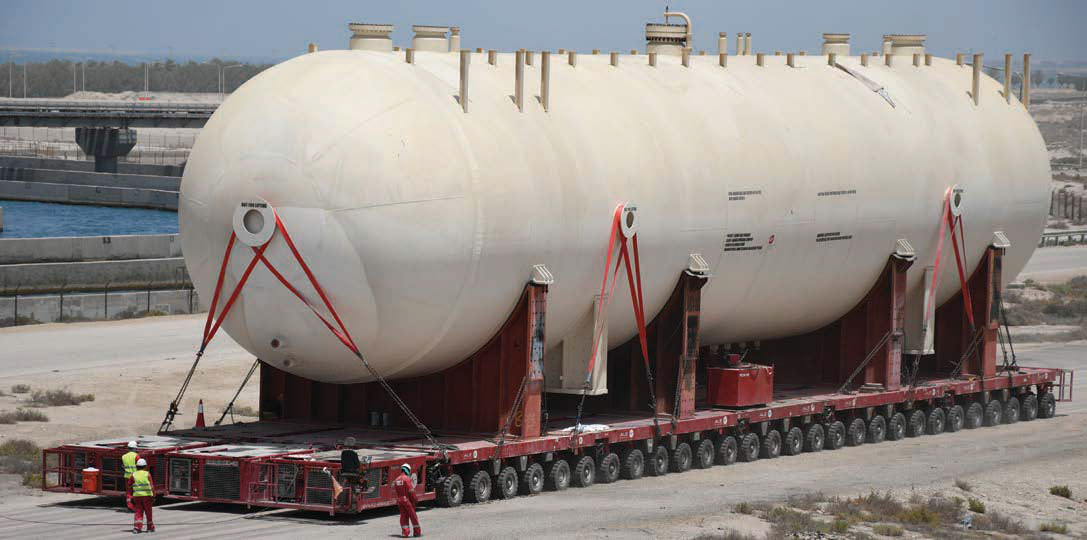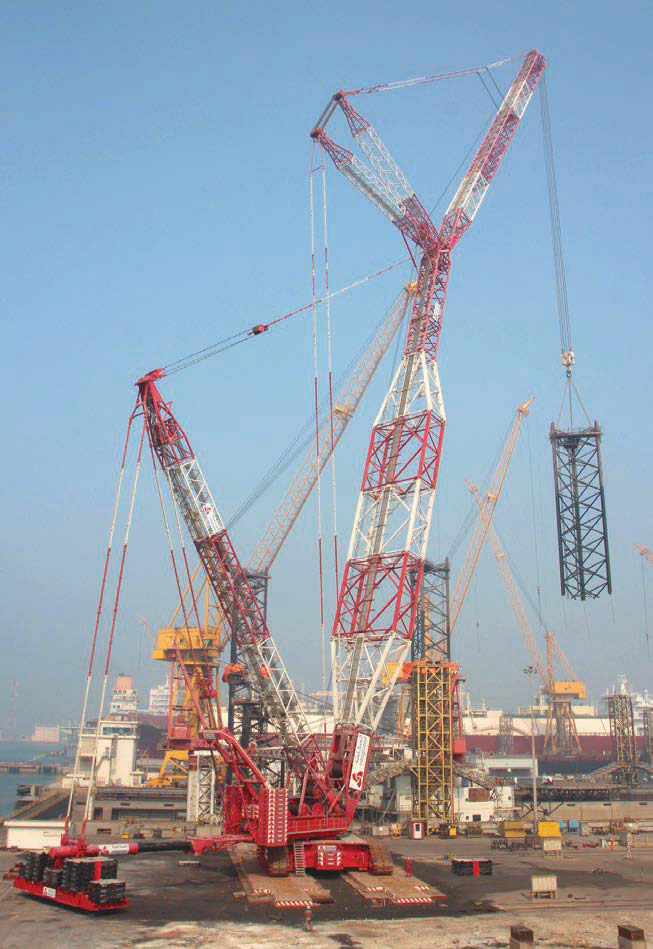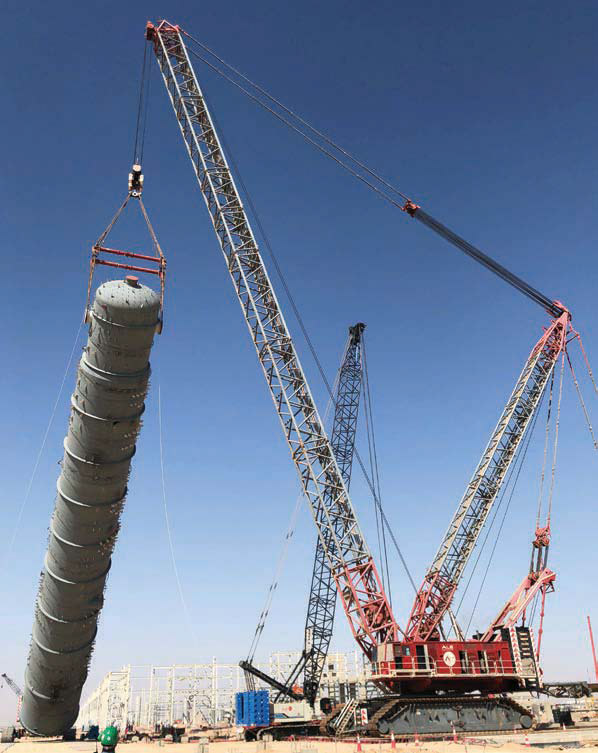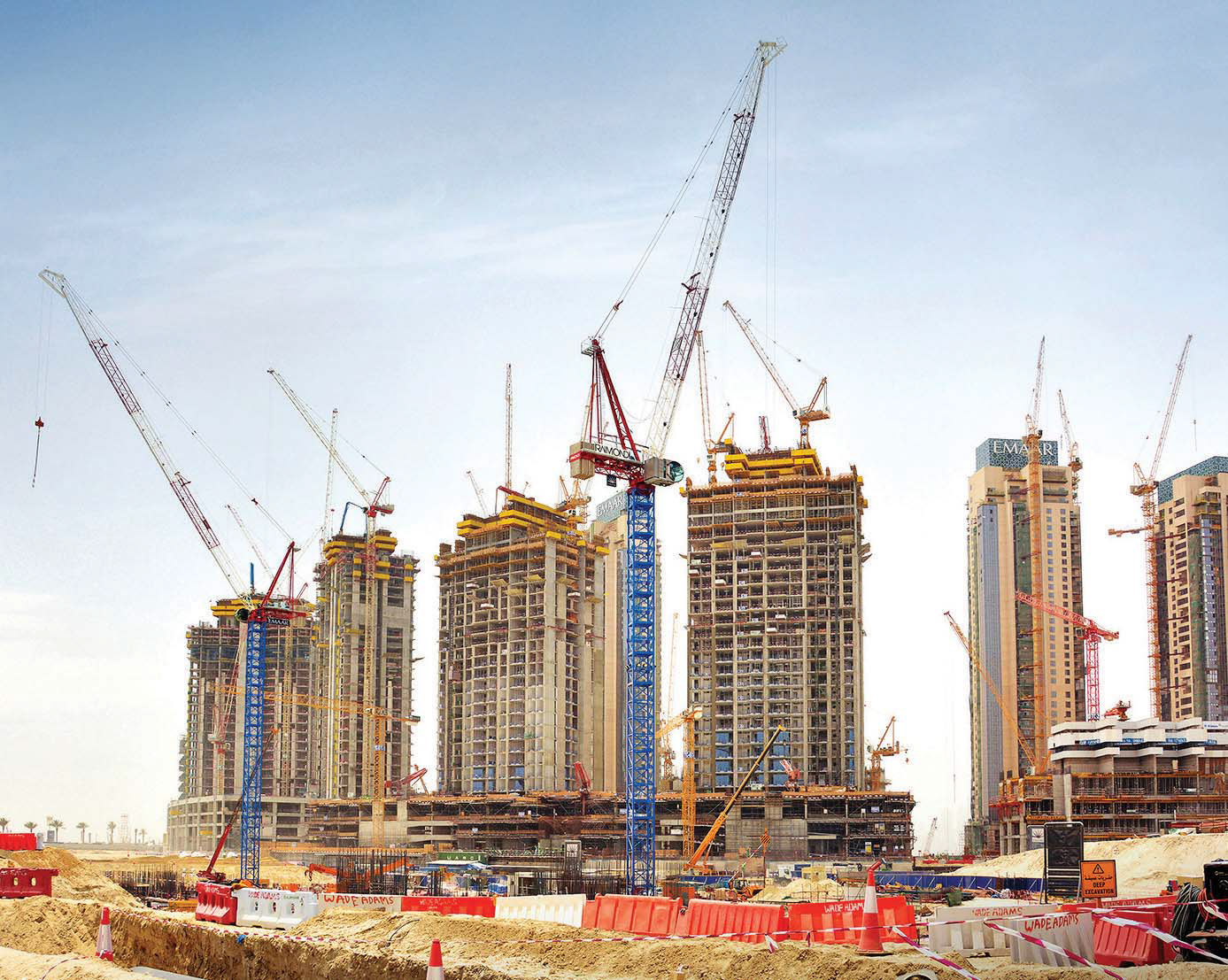Gulf cranes multiply
8 October 2018Construction activity is strong across the Middle East, Sotiris Kanaris looks at the crane market and interesting projects in the region.
After a short period of decline, the economies of the countries in the Middle East are picking up, triggering investments in residential, commercial and infrastructure projects.
This positive change was reflected in the success of the Big 5 Heavy show that took place in Dubai in March.
Andrea Bristot, area sales manager for the Middle East at Comansa, says: “During the three days of the show, we have been very busy with customers and potential buyers, not only from Emirates but also from Egypt, Oman, Saudi Arabia or Kuwait, which shows that the entire region is under an evident recovery. Another good indicator is that the world’s main tower crane manufacturers were at the Big 5 Heavy show.”
It is not suprising that tower crane manufacturers are targeting this region, as local demand for these machines is high, particularly in the UAE.
UAE-based tower crane supplier and Potain dealer NFT currently has 208 tower cranes on hire between Abu Dhabi, Dubai and Sharjah, not including sold cranes.
“Dubai’s driver is the Expo 2020 that has seen an impressive pace of progress. Construction is well advanced on the three ‘thematic districts’ that form the core of the expo site, named Mobility, Opportunity and Sustainability, all connected by Al Was Plaza, the centrepiece of the site,” says the tower crane supplier.
Expo 2020 is a universal exposition, which will take place between 20 October 2020 and 10 April 2021. It will be the fi rst World Expo to take place in the Middle East.
NFT says 45 tower cranes have been erected at the main Expo 2020 site, with the current works on the project centering on shade structure and canopy installations. NFT supplied seven Potain cranes, mixed between luffers like the MCR 225 and fl at tops such as the MDT 368 L16 able to lift up to 16t.
Apart from the main exposition site, there are numerous other major construction projects linked to the event. An example is the Expo Village, the residential development that will provide full-time housing facilities for participating countries’ staff working at the Expo. It will consist of fi ve 16-storey towers, comprising 2,273 apartment units.
There are 11 NFT tower cranes at this job site, with units from Potain’s MC 175, MCT 205 and MCR 225 models.
In order to facilitate people moves to and from the event, the Route 2020 is being constructed. It is a fi ve-stage extension of the Dubai Metro Red Line up to the World Exposition 2020 (Expo 2020). For this prject NFT has installed six Potain tower cranes.
There is also strong construction activity related to commercial developments. NFT has supplied 15 tower cranes for the Reem Mall, including the gigantic MD 1100 which can lift up to 40t.
Another mall currently under construction in the UAE, is the Dubai Hills Mall. lt will feature 2m sq ft of leasable space spread out over ground and first floor levels, over 650 retail and food and beverage outlets, family entertainment, Cineplex and hypermarket. For this project, developer Emaar has employed 18 Liebherr 280 EC-H Litronic high top tower cranes.
Residential construction is also strong in the UAE. Nurol Construction has put five Raimondi cranes to work at two residential jobsites in Dubai. Three MRT294 topless tower cranes, with maximum capacity of 16t, are situated at The Cove which consists of three residential towers. The company has also erected two LR213 luffers, with maximum capacity of 14t, at Creek Gate at Dubai Creek Harbor.
Two Raimondi MRT111 topless tower cranes, belonging to DAAC, are being used for the construction of the Riviera residential project by Azizi Developments in Meydan, Dubai. Comansa is also present in the UAE, with its dealer Al Rana Equipment & Machines Trading, also known as Aremates.
“Our rental fleet includes many Comansa tower cranes,” says Bassam Nowfal, general manager and owner of Aremates. “Cranes with maximum load capacity from 10 to 16t are currently most demanded in Emirates.”
The popularity of this capacity range is illustrated by the cranes used in the majority of the case studies above, as well as from the fact that NFT’s most popular is the MC 310 K12 hammerhead crane, which has a 70m jib, 3t at the tip and 12t maximum.
“The crane is considered large in Europe, but in GCC (Gulf Cooperation Council) countries it is the standard,” says NFT.
Nowfil says there is also demand for larger cranes, for projects like high rise residential or commercial buildings or the Metro. “Thanks to having Comansa cranes with higher capacity, like flat-top model 21LC550 (20 and 25t versions) or the 24t LCL280 luffer, we are able to work in any type of construction project that takes place in Emirates,” he adds.
The increased construction of high rise buildings, has boosted the demand for luffers in recent years.
“High rise towers, which are very popular in this region, require luffing cranes with a big capacity, such as the Potain MR 418,” says NFT.
Ten MR 418s have been installed The Royal Atlantis Residences for the past two years. This makes the Royal Atlantis jobsite the first in the UAE to use the new Potain machine. The MR 418s have been erected on fixing angles at heights ranging from 104m to 190m free standing.
NFT has seen increased demand for even higher capacity tower cranes in the region. “The GCC is quite unique when it comes to special requirements for heavy capacity cranes, with capacities from 30t to 60t. Our region definitely has the highest population of such cranes. Recently for the internal airport in Kuwait, NFT has erected many MD 1100s, which are very popular on large infrastructure projects that require the handling of large structural components.” They have a maximum capacity of 50t, while at their maximum jib length of 80m they can lift 10.6t.
Mobile cranes
Apart from tower cranes, the increased construction activity in the region has generated significant orders of mobile cranes.
Over the past year, a number of crane rental companies have boosted their fleet of rough terrains.
The natural environment of the region and the robustness of these machines makes them an important tool for various applications.
Al Faris Equipment Rentals, founded in 1992, is a family owned business with over 25 years of experience in the MENA region. Earlier this year, it took delivery of two new Liebherr rough terrain cranes at its company headquarters in Dubai, an LRT 1090-2.1 and an LRT 1100-2.1. These are the first units of the new Liebherr series to enter use in the Middle East. They are part of a major order from Al Faris of 14 LRT cranes and 13 LTM cranes that will be delivered by the end of the year.
Saudi Arabian crane rental company, Arabian Consolidated Trading has placed an order for four Terex RT 90 rough terrain cranes, alongside four Demag AC 160-5, two AC 300-6 all terrain cranes.
The Terex RT 90 has already proven itself in Saudi Arabia. A unit from this model, belonging to heavy equipment service provider Expertise Contracting Company, was used by Nabors at a construction site in Abqaiq. It was continously working for five months, lifting numerous components for drilling rigs, generators, and a power distribution and control center at the oil field.
The rough terrain crane completed most of the lifts solo, and only needed assistance when lifting a 60t steel container that housed the power distribution and control center for the drilling zone. For this particular lift, a Terex RT 780 rough terrain crane was deployed to complete the task as a tandem lift.
Tadano rough terrains and all terrains can also be found working in the region. Al Kulaib International Trading company specialising in civil, mechanical and engineering works in Kuwait, took delivery of eight models from the Japanese manufacturer this year.
Al Kulaib’s newest Tadano cranes are: from the all terrain series, an ATF 180G-5, an ATF 130G-5 and an ATF 100G-4; from the rough terrain series, a GR-800EX and two GR- 500EXL cranes; and two GT-600EL truck cranes.
Al Anis Trading Company is a well-known name in the Gulf state of Qatar, one of its most recent purchases is a new 400t ATF 400G- 6, supplied by Tadano Middle East through its local dealer, Qatar Tractor & Equipment.
In Qatar, they are getting ready for the World Cup in 2022. As the country prepares for the world’s most prestigious football tournament, construction is already in full swing on the Doha Metro System, new orbital highways and expressways, as well as new stadiums.
In this flurry of new construction projects, Sarens has deployed a fleet of 17 cranes to help build one of eight stadiums that will host the country’s World Cup championship matches.
In collaboration with the Salini Impregilo Group and Galfar and Cimolai joint venture (GSIC JV), along with Cimolai, Sarens has provided cranes for the construction of the iconic Al Bayt Stadium in the city of Al Khor, famous for its pearl diving and fishing. The stadium’s design is inspired by traditional Bedouin tents, which symbolise the hospitality of the Qatari people, and once complete it will host 60,000 football fans in an area spanning 200,000sqm.
For this project, a total of 17 mobile and crawler cranes were mobilised on-site over a period of 18 months. These included a 1,250t Demag crawler, nine Liebherr crawlers with capacities ranging from 100t to 750t, five Liebherr all terrains with capacities ranging from 70t to 500t, a 135t Kobelco crawler and an 80t Tadano rough terrain. In Qatar, a high capacity crawler crane was recently used for an application outside the construction sector.
Middle East logistics provider Integrated Logistics deployed a 1,600t-capacity Terex Demag CC8800-1 Boom Booster to install Rumailah Spudcan and leg sections on behalf of Nakilat-Keppel Offshore & Marine (N-KOM).
N-KOM is a joint venture between Qatar’s premier gas shipper Nakilat and leading offshore rig constructor and ship repairer Keppel Offshore & Marine. Located in the heart of the Arabian Gulf and within the Erhama Bin Jaber Al Jalahma Shipyard complex, N-KOM offers a comprehensive range of repair, conversion, maintenance and fabrication services for marine vessels, offshore and onshore structures.
For this job, Integrated Logistics assembled the crane Terex Demag CC8800-1 Boom Booster lattice boom crawler crane in BSFSL configuration with 82m main boom and 72m jib. It used the super lift counter weight of 800t for the weightiest leg section. The supporting crane was a 300t Liebherr LR1300 SX lattice boom crawler crane in HSDB configuration with 41m main boom. The biggest leg section,
40.5m tall and weighing 246t, was erected at a working radius of 75m. Integrated Logistics runs a fleet of crawler, all terrain, rough terrain, truck and boom truck cranes, ranging from three to 2,300t. In 2018, Integrated Logistics enhanced its fleet of crawler cranes with the addition of two new 650t-capacity Demag CC 3800-1 lattice boom crawlers.
Al Faris used its Demag CC3800-1 crawler crane for a similar application in the UAE. It dispatched a team to Hamriyah, at one of the biggest shipyards in the region, to lift three 72m-long 130t spud legs from a barge. The crawler crane was configured with a 108m-long main boom and a Superlift mast with a length of 36m.
The central ballast totaled 50t, the Superlift counterweight 325t, and the counterweight on the superstructure 165t. Once set up this way, the CC 3800-1 was ready to lift the three spud legs (weighing 130t each) at a maximum radius of 50m, swing them to the side, and then set them in place with the help of a 150t crawler crane.
Power up In this region, high capacity crawler cranes are very popular due to the high number of energy related projects and construction of industrial facilities.
Mammoet has been involved in the expansion of a polypropylene plant in the Gulf Coast, which will increase the site production capacity by an additional 450,000t a year.
A Liebherr LR13000 crawler crane with a 96m boom was used to install two reactors from one position. The crane was outfitted in a complex boom configuration, boasting a lifting radius of 33.5m and superlift capacity of 1,500t.
The larger reactor weighed a total of 725t and stretched 49m long. These lifts were executed successfully with tailing help from one of Mammoet’s Terex CC2800 crawler cranes.
After these lifts were completed in July, Mammoet reconfigured the LR13000 with a luffing jib to execute a further 16 lifts, ranging from 38.5 to 482t. The crane was configured with a tall 96m main boom and 72m luffing jib. The heaviest component, a purge bin, was lifted from saddle supports with tailing help from the CC2800, carefully swung around 180° and ultimately lifted into an existing housing structure within a three hour time window. During several of the lifts, the total crane radius was nearly 129m.
A Liebherr crawler was also used by Al Faris in another power plant in the region. A 1,000t LR11000 lattice boom crawler performed 12 heavy lifts of various sized generators, the largest weighing 404t which were to be lifted in confined spaces between structures.
The crawler crane was used in SDWB2 configuration (main boom 48m, luffer 30m) while lifting the 404t generator. The entire execution included lifting of the generator from the hydraulic trailer and manoeuvering the crane with the load towards the foundation, which was approximately 10m distance away to achieve the planned radius.
The load was then hoisted to a height of 30m and rotated over a high rise steel structure and slowly lowered to approximately 15m within the narrow space between the steel structures to the foundation level.
The final alignment of the load was done by coordinating with the installation team. A similar lifting procedure was followed to safely lift the remaining 11 generators.
ALE has also been involved in an energy project in the region, performing heavy lifting works at the Karbala Refinery Project in Iraq. The global heavylifting contractor has been tasked to perform more than 350 lifts of refinery components over one year.
ALE used its extensive fleet of equipment to carry out this project in the most efficient way: 24 cranes, ranging from 50t to 1,600t, were deployed.
The cranes used with capacities exceeding 100t were: a 150t Sany SCC1500D, a 150t Hitachi Sumitomo SCX 1500-2, three 275t Hitachi Sumitomo SCX 2800-2, a 400t Terex CC2400-1, a 600t Terex CC2800-1, a 750t Manitowoc M18000, and a 1600t Terex CC8800-1. ALE said the CC8800-1 was the largest capacity crane to ever be deployed in Iraq.
Alongside the crane ALE used a number of conventional trailers, together with 48 axles of Scheuerle SPMTs, for the onsite movement of heavy cargo.
The construction of power plants require specialised transport solutions for heavy components.
ALE recently completed the challenging transportation of two large refinery components, known as slug catchers, and weighing 2,008t each, from Spain to Saudi Arabia, to the Fadhili Gas Program Project site.
ALE first transported the slug catchers from the fabrication yard through the narrow streets of Gijon city centre to Gijon Port using 32 axle lines of SPMT and then loadedout. Upon arrival at Jubail Industrial Port, the slug catchers were loadedin and transported 90km in convoy to the Fadhili Gas Program Project using 174 axle lines of Scheuerle SPMTs.
Another special transport project in the region involved the transportation of complex cargo at Aluminium Bahrain Potline 6 reduction plant in Bahrain.
Sarens was commissioned by air pollution control specalist Fives to undertake the transport and installation of the company’s Ozeos filters and pot tending machines (PTM). The team will deliver 36 pre-assembled Fives’ Ozeos filters for the two gas treatment centres. and 12 preassembled PTMs will be delivered and installed in the pot room at Line 6 plant. This is the first time that Fives had delivered its completely pre-assembled sections by SPMTs. Sarens deployed its 24 axles lines of the new rebuilt edition of Kamag K24 trailers (K24-R). Each Ozeos filter weighed around 49t and measured 9.4m x 6.5m x 16m, whereas each PTM weighed 150t and measured 24.3m x 12.3m x 10.6m.
The combination of big upcoming events (Expo 2020 and the World Cup) and the high number of energy related projects in the region have been keeping cranes busy. However, the economic recovery has triggered higher investment in residential and commercial developments, improving the crane market even further. The crane industry in the Middle East is well equipped for any type of project.
